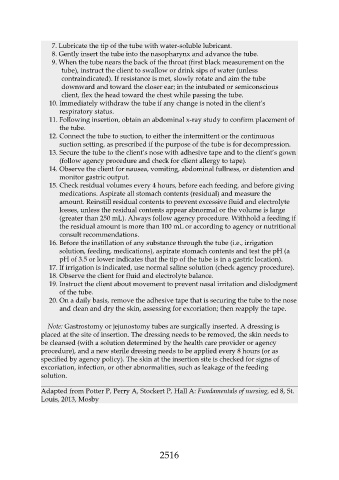Page 2516 - Saunders Comprehensive Review For NCLEX-RN
P. 2516
7. Lubricate the tip of the tube with water-soluble lubricant.
8. Gently insert the tube into the nasopharynx and advance the tube.
9. When the tube nears the back of the throat (first black measurement on the
tube), instruct the client to swallow or drink sips of water (unless
contraindicated). If resistance is met, slowly rotate and aim the tube
downward and toward the closer ear; in the intubated or semiconscious
client, flex the head toward the chest while passing the tube.
10. Immediately withdraw the tube if any change is noted in the client’s
respiratory status.
11. Following insertion, obtain an abdominal x-ray study to confirm placement of
the tube.
12. Connect the tube to suction, to either the intermittent or the continuous
suction setting, as prescribed if the purpose of the tube is for decompression.
13. Secure the tube to the client’s nose with adhesive tape and to the client’s gown
(follow agency procedure and check for client allergy to tape).
14. Observe the client for nausea, vomiting, abdominal fullness, or distention and
monitor gastric output.
15. Check residual volumes every 4 hours, before each feeding, and before giving
medications. Aspirate all stomach contents (residual) and measure the
amount. Reinstill residual contents to prevent excessive fluid and electrolyte
losses, unless the residual contents appear abnormal or the volume is large
(greater than 250 mL). Always follow agency procedure. Withhold a feeding if
the residual amount is more than 100 mL or according to agency or nutritional
consult recommendations.
16. Before the instillation of any substance through the tube (i.e., irrigation
solution, feeding, medications), aspirate stomach contents and test the pH (a
pH of 3.5 or lower indicates that the tip of the tube is in a gastric location).
17. If irrigation is indicated, use normal saline solution (check agency procedure).
18. Observe the client for fluid and electrolyte balance.
19. Instruct the client about movement to prevent nasal irritation and dislodgment
of the tube.
20. On a daily basis, remove the adhesive tape that is securing the tube to the nose
and clean and dry the skin, assessing for excoriation; then reapply the tape.
Note: Gastrostomy or jejunostomy tubes are surgically inserted. A dressing is
placed at the site of insertion. The dressing needs to be removed, the skin needs to
be cleansed (with a solution determined by the health care provider or agency
procedure), and a new sterile dressing needs to be applied every 8 hours (or as
specified by agency policy). The skin at the insertion site is checked for signs of
excoriation, infection, or other abnormalities, such as leakage of the feeding
solution.
Adapted from Potter P, Perry A, Stockert P, Hall A: Fundamentals of nursing, ed 8, St.
Louis, 2013, Mosby
2516

